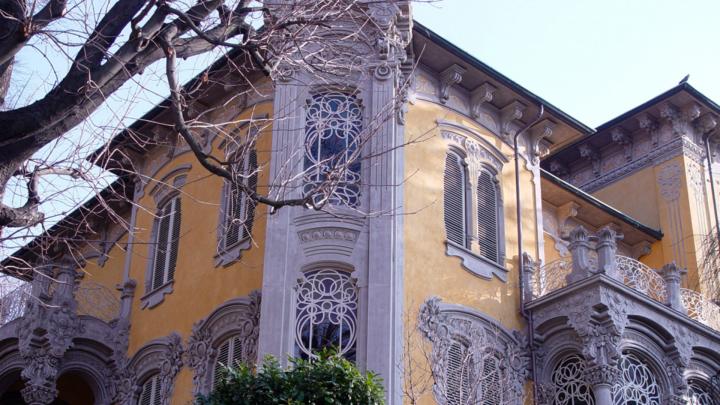A new artistic movement concerned architecture and applied art between the late 19th and early 20th centuries. It is called Art Nouveau in France, Jugendstil in Germany, Secession in Austria and Modern Style in Great Britain. In Italy it is more simply called “Liberty” and it spread with the 1902 Torino Exposition. This new style involved architecture, painting, sculpture and any item used in daily life invaded cities. Floral motifs, delicate veining, plant-like ambiance, tendrils and mouldings all became distinctive traits of the bourgeoisie leading the modernization of the city. Eccentric, sinuous and elegant, Liberty was established thanks to the work of architect Pietro Fenoglio who “redesigned” an entire portion of the city, the so-called “via di Francia” (the French road”) that connects piazza Statuto to Rivoli. Here, aside from Villino Raby (corso Francia 8), Fenoglio designed many buildings by combining the linear features of their stucco frames with decorative elegance, finding a way to make new techniques of industrial building – iron and glass-brick – coexist with daring structural shapes. The “La Fleur” building is an example (located at the corner of via Principi d’Acaja and corso Francia). The architect designed it for himself and it features a cantilever roof in the shape of a floral corolla emphasized by a stucco motif. The building, with a taller corner tower and various balconies, features windows with stained-glass windows and wrought iron with floral motifs. Façade decorations are painted in light colours, typical of the Liberty movement: green, pink and powder blue. Casa Tasca (via Baumont 3) is a frenzy of bow windows, designed by Giovan Battista Benazzo in 1903. Three small houses with gardens are worth mentioning: located on via Piffetti and designed by Giovanni Gribodo. They are famous for their wrought iron, decorations in the shape of peacock tails, floral decorations and the characteristic sphinxes.
Other examples of Liberty style are Palazzo Maffei in corso Montevecchio 50 and several buildings along the corso Galileo Ferraris and corso Re Umberto that are characterised by their wrought iron, stain-glass windows and floral motifs. Villa Javelli is another noteworthy example, located on via Petrarca 44, designed by Raimondo D’Aronco, who also designed the pavilions for the Modern Decorative Art Exposition at Valentino in 1902. But the masterpiece of Torino’s Liberty style is Villa Scott on corso Giovanni Lanza 57, designed by Pietro Fenoglio; a frenzy of loggias, towers, bow windows and windows with abstract or naturalistic decorations that Dario Argento chose to shoot on location for his “The Deep Red Hatchet Murders”.
Lastly, the first Fiat factory on corso Dante 10 at the corner of via Marochetti 1 cannot be forgotten: the FIAT acronym is framed by floral motifs that are also seen on the window frames and along the window gratings.
Another extraordinary example of Liberty taste is the Caffé Mulassano in piazza Castello 9. Designed by Antonio Vandone, it features a sunken panel ceiling (coffer) in wood and leather, walls covered in mirrors and panelling, a counter with an onyx surface and decorations in bronze created by the finest artisans of the day. Right next door stands another one of Torino’s historic cafès: Baratti & Milano in piazza Castello 29,overlooking the arcades with an imposing marble frame embellished with bas-reliefs in bronze. The interior has a wealth of decoration: inlaid marble, rose ceilings, golden stucco as well as elaborate frames and doorframes. The exterior that opens onto the Galleria Subalpino is significant, recalling Parisian “passages”. This and the Galleria San Federico are architectural jewels of that extraordinary era.

